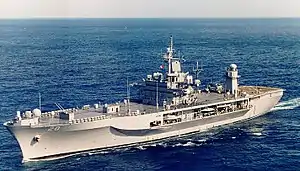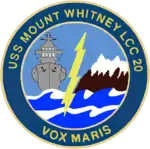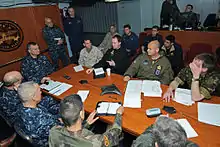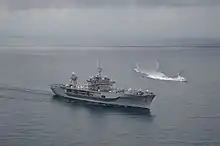USS Mount Whitney (LCC-20)
USS Mount Whitney (LCC/JCC 20) is one of two Blue Ridge-class amphibious command ships of the United States Navy and is the flagship and command ship of the United States Sixth Fleet. USS Mount Whitney also serves as the Afloat Command Platform (ACP) of Naval Striking and Support Forces NATO (STRIKFORNATO). The ship had previously served for years as the COMSTRIKFLTLANT(NATO Designation) / US Second Fleet's command ship. She is one of only a few commissioned ships to be assigned to Military Sealift Command.[1]
 USS Mount Whitney underway | |
| History | |
|---|---|
| Name: | USS Mount Whitney |
| Namesake: | Mount Whitney |
| Ordered: | 10 August 1966 |
| Builder: | Newport News Shipbuilding & Drydock Company |
| Laid down: | 8 January 1969 |
| Launched: | 8 January 1970 |
| Commissioned: | 16 January 1971 |
| Homeport: | Gaeta, Italy |
| Identification: |
|
| Status: | In active service |
| Badge: |
 |
| General characteristics | |
| Class and type: | Blue Ridge-class command ship |
| Displacement: | 18,400 tons full load |
| Length: | 189 m (620.1 ft) |
| Beam: | 33 m (108.3 ft) |
| Draft: | 906.78 cm (29.8 ft) full load |
| Propulsion: | Two boilers, one geared turbine |
| Speed: | 23 knots (43 km/h; 26 mph) |
| Capacity: | 930 |
| Complement: |
|
| Armament: |
|
| Aircraft carried: | 1 × helicopter, currently a MH-60S Knight Hawk |
Mount Whitney was classified as LCC-20 on 1 January 1969, and her keel was laid down on 8 January by Newport News Shipbuilding & Drydock Company, Newport News, Virginia.
At the time of her commissioning, Mount Whitney joined her sister ship Blue Ridge as having the distinction of carrying the world's most sophisticated electronics suites. It was said to be some thirty percent larger than that of the aircraft carrier USS John F. Kennedy, which had been the most complex. Mount Whitney was armed with a "main battery" of computers, communications gear, and other electronic facilities to fulfill her mission as a command ship. An extremely refined communications system was also an integral part of the ship's radical new design. Through an automated patch panel and computer-controlled switching matrix, her crew could use any combination of communication equipment desired. The clean topside area is the result of careful design intended to minimize the ship's interference with her own communications system. US Navy long-range communications were heavily reliant on high-frequency radio systems in the 1970s and have evolved to predominantly satellite communications in the 2000s. This is illustrated by the long wire antennas and the directional HF yagi or log-periodic antenna initially installed on Mount Whitney and later removed and replaced with a number of satellite communications antennas.
Etymology
The ship is named for Mount Whitney, a peak in the Sierra Nevada mountain range of California. Mount Whitney is the highest summit in the contiguous United States, with an elevation of 14,505 feet (4,421 m).[2]
Capability
Mount Whitney is the most sophisticated Command, Control, Communications, Computer, and Intelligence (C4I) ship ever commissioned,[3] She incorporates various elements of the most advanced C4I equipment and gives the embarked Joint Task Force Commander the capability to effectively command all units under their command.
Mount Whitney can transmit and receive large amounts of secure data to and from any point on earth through HF, UHF, VHF, and SHF (satellite) communications channels. This electronic technology enables the Joint Intelligence Center and Joint Operations Center to provide the most timely intelligence and operational support available in the Navy.
Ship history
1970s and 1980s
From 1971 to 2005, Mount Whitney served as the flagship for Commander Second Fleet/Commander Striking Fleet Atlantic.
1990s
In 1994, during the FleetEx 2/94 "George Washington" war game exercise, the Argentine Navy, acting as the enemy and using the diesel submarine ARA San Juan, went undetected, penetrated the destroyer defense and "sank" Mount Whitney, which was acting as the command ship during the exercise.[4][5]
Mount Whitney deployed in 1994 to Haiti with Lieutenant General Hugh Shelton, the commander of the XVIII Airborne Corps, in command of the Joint Task Force that conducted Operation Uphold Democracy.
2000s

On 12 November 2002, Mount Whitney deployed to the Central Command area of responsibility in support of Operation Enduring Freedom. She was acting as the initial command post for Combined Joint Task Force - Horn of Africa. During the deployment, the ship embarked elements of the 2nd Marine Division and II Marine Expeditionary Force (II MEF), based at Camp Lejeune, North Carolina, under the command of Major General John F. Sattler and Captain Morton W. Kenyon.
In 2004, Military Sealift Command civilian sailors were integrated into her crew. She remains a commissioned warship in the United States Navy, but the size of her crew was reduced from about 600 sailors to about 170 Navy officers and enlisted personnel and 155 civilians.
In February 2005, Mount Whitney left Norfolk for Gaeta, Italy where she was redesignated (LCC/JCC 20) and assumed duties as the 6th Fleet flagship, officially relieving USS La Salle. She also assumed duties as the command ship for the Commander, Joint Command Lisbon and the Commander, Striking Force NATO.
In August 2008, Mount Whitney was deployed to the Black Sea in support of Operation Assured Delivery to deliver humanitarian aid to those affected by the Russo-Georgian War[6] and became the first NATO ship to deliver aid to port of Poti, Georgia.[7]
On 6 November 2008, Mount Whitney was unable to enter the port at Sevastopol. City authorities and representatives of the Ukrainian Navy refused to comment on the event. Individuals working for the city administration reported that the failure was due to issues with Mount Whitney's border crossing documents, while others suggested anti-NATO protests were the cause.[8]
2010s

From 19 March 2011, Mount Whitney served in the Mediterranean as the main command vessel for the enforcement of United Nations Security Council Resolution 1973 against Libya.[9] She was the flagship for Admiral Samuel J. Locklear, who had tactical command of the Operation Odyssey Dawn joint task force.[10][11] The vessel was serving as a command-and-control vessel for the United States' involvement in the coalition campaign aimed to enforce a Libya no-fly zone and prevent Muammar Gaddafi's forces from attacking the rebel stronghold of Benghazi.[12]

In February 2013, Mount Whitney transferred to the San Giorgio del Porto Shipyard in Genoa, Italy for a major 60-day overhaul and repair project.[13] The ship returned to active duty in April 2013 at the end of the maintenance window.
On 31 January 2014, Mount Whitney left her homeport of Gaeta, Italy.[14] Mount Whitney, along with USS Taylor, were the first two US Navy ships to operate in the Black Sea during the Sochi Olympics.
On 31 July 2015, a fire broke out aboard Mount Whitney while she was in Viktor Lenac Shipyard, Rijeka, Croatia. There were no reported injuries, and the fire was extinguished within 45 minutes by ship's crew and shipyard fire brigade personnel. Mount Whitney had been in Viktor Lenac Shipyard since January 2015 undergoing a scheduled maintenance overhaul designed to extend the service life of the ship to 2039.[15]
On 30 June 2016, Mount Whitney visited Klaipėda, Lithuania, and in October 2016, she visited Souda Bay, Greece.[16]
From early 2017 through to October 2017, Mount Whitney was at the Viktor Lenac Shipyard; Rijeka, Croatia, for further upgrades to its information technology infrastructure, and various engineering refurbishments.[17]
In September 2018, Mount Whitney visited Thessaloniki, Greece, for the 83rd Thessaloniki International Fair, where the US was the country of honor.[18]
From 25 October to 7 November 2018, she served as the command vessel for the NATO exercise Trident Juncture.[19]
Gallery
- USS Mount Whitney Lifecycle
_launches_a_RIM-7_Sea_Sparrow_missile%252C_in_1976.jpg.webp) USS Mount Whitney launches a RIM-7 Sea Sparrow Missile in 1976.
USS Mount Whitney launches a RIM-7 Sea Sparrow Missile in 1976. Battle of Midway ceremony aboard USS Mount Whitney on 5 June 2013.
Battle of Midway ceremony aboard USS Mount Whitney on 5 June 2013._is_underway_in_the_Baltic_Sea_June_16%252C_2013%252C_during_Baltic_Operations_(BALTOPS)_2013_130616-N-ZL691-013.jpg.webp) USS Mount Whitney underway in Baltic Sea on 16 June 2013.
USS Mount Whitney underway in Baltic Sea on 16 June 2013. USS Mount Whitney in Batumi, Georgia in 2013.
USS Mount Whitney in Batumi, Georgia in 2013..jpg.webp) January 2015, USS Mount Whitney in floating drydock in Rijeka, Croatia.
January 2015, USS Mount Whitney in floating drydock in Rijeka, Croatia._in_Kiel_Germany_2018.jpg.webp) USS Mount Whitney in Kiel, Germany in 2018
USS Mount Whitney in Kiel, Germany in 2018_COVID-19_test_in_Gaeta%252C_Italy%252C_May_6%252C_2020-_200506-N-RG482-0099_(49870147618).jpg.webp) USS Mount Whitney testing for COVID-19 in Gaeta, Italy, 6 May 2020.
USS Mount Whitney testing for COVID-19 in Gaeta, Italy, 6 May 2020.
Awards
- Navy Unit Commendation with 2 awards
- Navy Meritorious Unit Commendation with 2 awards
- Naval Battle “E” Ribbon with 11 awards
- National Defense Service Medal with 2 awards
- Armed Forces Expeditionary Medal
- Global War on Terrorism Expeditionary Medal
- Kosovo Service Medal with 2 awards
- United Nation Medal
References
- "Ships of the Military Sealift Command" (PDF). U.S. Navy. 2017. Archived from the original (PDF) on 28 September 2017. Retrieved 22 January 2018.
- "NGS data sheet: Mount Whitney (1994)". U.S. National Geodetic Survey. 1 November 2015. Archived from the original on 2 November 2015. Retrieved 25 November 2017.
- "USS Mount Whitney: History". United States Navy. Retrieved 25 November 2017.
- "El día que el ARA San Juan sorprendió a la Armada de Estados Unidos" [The day that the ARA San Juan surprised the United States Navy]. La Nación (in Spanish). 22 November 2017. Retrieved 22 November 2017.
- "Ejercicio Fleetex 2/94 "George Washington"". Comunidad Submarinista Latinoamericana (in Spanish). 12 August 2014. Retrieved 22 November 2017.
- "Second U.S. ship delivers aid to Georgia". U.S. Sixth Fleet Public Affairs. 27 August 2008. Archived from the original on 30 August 2008. Retrieved 25 November 2017.
- "US delivers aid to Georgian port". BBC News. 5 September 2008. Retrieved 25 November 2017.
- Arvidas, Shemetas (6 November 2008). "USS Mount Whitney fails to enter Sevastopol Port". Ukrinform. Retrieved 9 September 2013.
- "Libya Live Blog". Al Jazeera. Archived from the original on 20 March 2011. Retrieved 25 November 2017.
- MacAskill, Ewen & Hopkins, Nick (21 March 2011). "Libyan operation hampered by confusion and dispute: Lack of resolution over who will take control of military operation tests patience of US". The Guardian. Retrieved 25 November 2017.
- "Gunfire, explosions heard in Tripoli". CNN. 19 March 2011. Retrieved 25 November 2017.
- "White House hails Arab League no-fly zone request". Yahoo! News. 12 March 2011. Archived from the original on 14 March 2011. Retrieved 20 March 2011.
- "San Giorgio del Porto welcomes to Genoa USS Mount Whitney". San Giorgio del Porto. Archived from the original on 18 March 2013. Retrieved 22 February 2013.
- Martinez, Luis (31 January 2014). "First US Navy Warship Heads to Black Sea as Potential Backup for Sochi". ABC News. Archived from the original on 2 February 2014. Retrieved 2 February 2014.
- 6th Fleet Public Affairs (1 August 2015). "Fire Aboard USS Mount Whitney; No Injuries" (Press release). United States Navy. Retrieved 25 November 2017.
- "Klaipėdoje lankosi JAV karinis laivas USS Mount Whitney" [USS Mount Whitney, a US military ship, is visiting Klaipėda]. Ministry of National Defense of Lithuania (in Lithuanian). 30 June 2016. Retrieved 25 November 2017.
- Pavlic, Vedran (30 March 2017). "Croatian Shipyard Overhauls USS Mount Whitney". Total Croatia News. Retrieved 25 November 2017.
- "Η Αμερικανική Ναυαρχίδα USS Mount Whitney στη Θεσσαλονίκη" [American flagship USS Mount Whitney in Thessaloniki]. OnAlert.gr (in Greek). 10 September 2018. Retrieved 10 September 2018.
- "STRIKFORNATO will exercise the integration of Carrier Strike Group Eight during Trident Juncture". STRIKFORNATO - Naval Striking and Support Forces NATO. Retrieved 4 November 2018.
External links
| Wikimedia Commons has media related to USS Mount Whitney (LCC-20). |
- Official website
- "USS Mount Whitney". Military Sealift Command. Archived from the original on 27 March 2018.
- Photo gallery of USS Mount Whitney (LCC-20) at NavSource Naval History
- USS Mount Whitney (LCC 20) at navysite.de